Comparative Analysis of Competitive Advantages: OLI and LLL Frameworks
VerifiedAdded on 2019/11/20
|17
|3573
|244
Essay
AI Summary
The rise of Asian Pacific multinationals is a phenomenon that cannot be fully explained by the OLI and LLL frameworks, which have been criticized for neglecting learning and resource-based aspects within latecomer multinationals. The assignment aims to understand the dominant strategies adopted by these multinationals, particularly in the areas of foreign direct investment, trade relationships, and HRM practices. It highlights the unique characteristics of Chinese and Japanese investors, including their targeting of secondary and tertiary sectors, and their interests in maintaining trade relationships with East Asian countries. Ultimately, the assignment seeks to provide a comprehensive understanding of the factors that contribute to the success of Asia Pacific multinationals.
Contribute Materials
Your contribution can guide someone’s learning journey. Share your
documents today.
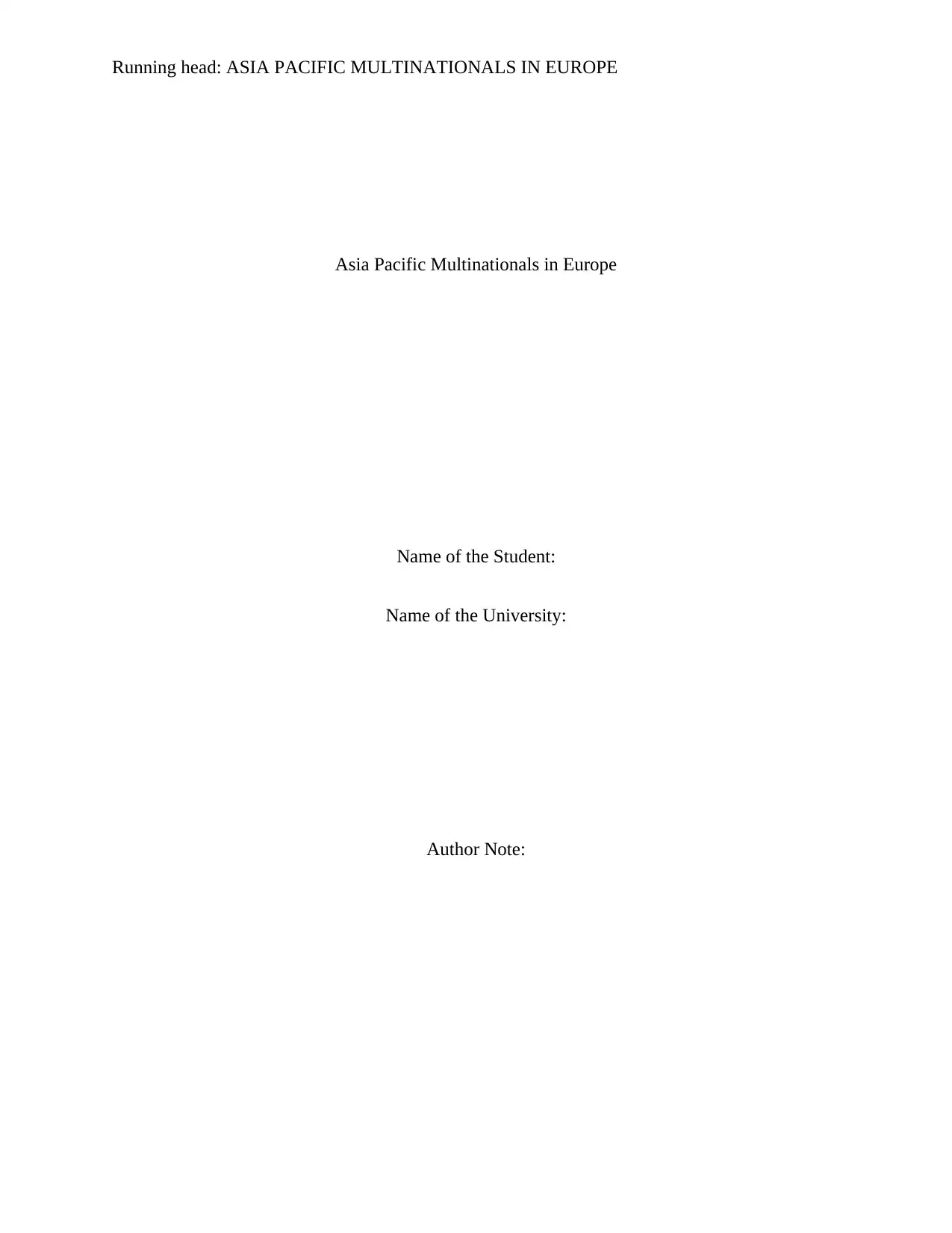
Running head: ASIA PACIFIC MULTINATIONALS IN EUROPE
Asia Pacific Multinationals in Europe
Name of the Student:
Name of the University:
Author Note:
Asia Pacific Multinationals in Europe
Name of the Student:
Name of the University:
Author Note:
Secure Best Marks with AI Grader
Need help grading? Try our AI Grader for instant feedback on your assignments.
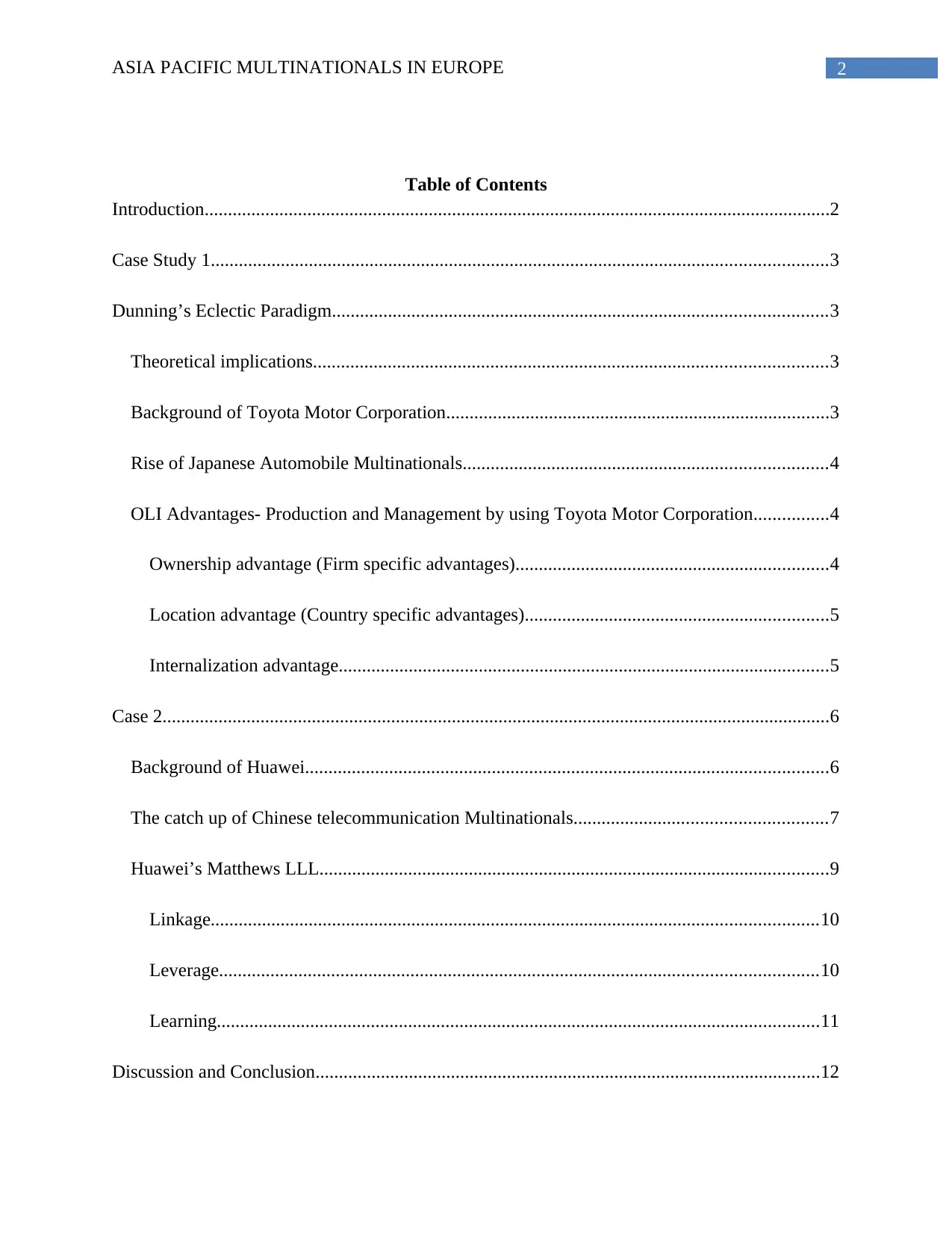
2ASIA PACIFIC MULTINATIONALS IN EUROPE
Table of Contents
Introduction......................................................................................................................................2
Case Study 1....................................................................................................................................3
Dunning’s Eclectic Paradigm..........................................................................................................3
Theoretical implications..............................................................................................................3
Background of Toyota Motor Corporation..................................................................................3
Rise of Japanese Automobile Multinationals..............................................................................4
OLI Advantages- Production and Management by using Toyota Motor Corporation................4
Ownership advantage (Firm specific advantages)...................................................................4
Location advantage (Country specific advantages).................................................................5
Internalization advantage.........................................................................................................5
Case 2...............................................................................................................................................6
Background of Huawei................................................................................................................6
The catch up of Chinese telecommunication Multinationals......................................................7
Huawei’s Matthews LLL.............................................................................................................9
Linkage..................................................................................................................................10
Leverage................................................................................................................................10
Learning.................................................................................................................................11
Discussion and Conclusion............................................................................................................12
Table of Contents
Introduction......................................................................................................................................2
Case Study 1....................................................................................................................................3
Dunning’s Eclectic Paradigm..........................................................................................................3
Theoretical implications..............................................................................................................3
Background of Toyota Motor Corporation..................................................................................3
Rise of Japanese Automobile Multinationals..............................................................................4
OLI Advantages- Production and Management by using Toyota Motor Corporation................4
Ownership advantage (Firm specific advantages)...................................................................4
Location advantage (Country specific advantages).................................................................5
Internalization advantage.........................................................................................................5
Case 2...............................................................................................................................................6
Background of Huawei................................................................................................................6
The catch up of Chinese telecommunication Multinationals......................................................7
Huawei’s Matthews LLL.............................................................................................................9
Linkage..................................................................................................................................10
Leverage................................................................................................................................10
Learning.................................................................................................................................11
Discussion and Conclusion............................................................................................................12
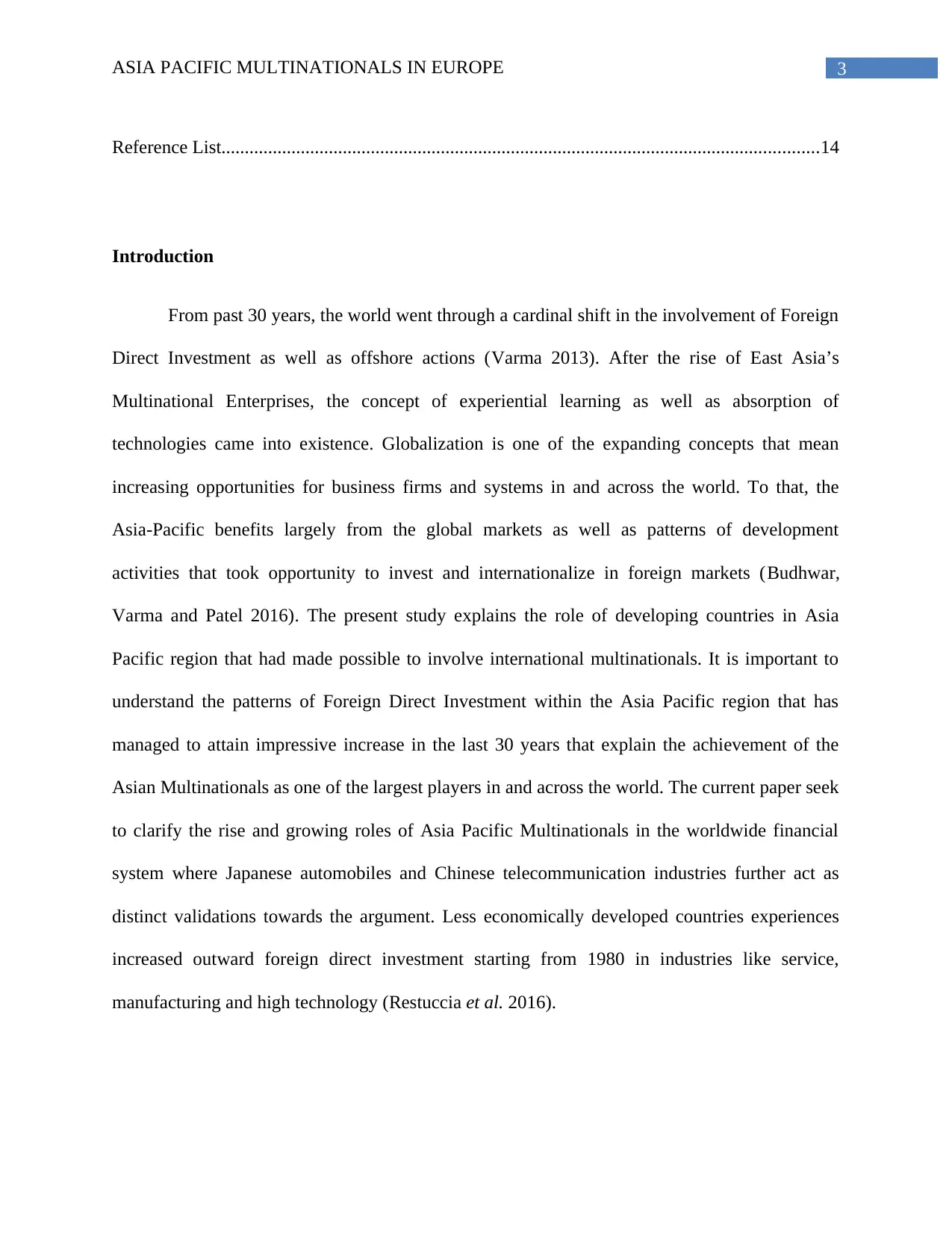
3ASIA PACIFIC MULTINATIONALS IN EUROPE
Reference List................................................................................................................................14
Introduction
From past 30 years, the world went through a cardinal shift in the involvement of Foreign
Direct Investment as well as offshore actions (Varma 2013). After the rise of East Asia’s
Multinational Enterprises, the concept of experiential learning as well as absorption of
technologies came into existence. Globalization is one of the expanding concepts that mean
increasing opportunities for business firms and systems in and across the world. To that, the
Asia-Pacific benefits largely from the global markets as well as patterns of development
activities that took opportunity to invest and internationalize in foreign markets (Budhwar,
Varma and Patel 2016). The present study explains the role of developing countries in Asia
Pacific region that had made possible to involve international multinationals. It is important to
understand the patterns of Foreign Direct Investment within the Asia Pacific region that has
managed to attain impressive increase in the last 30 years that explain the achievement of the
Asian Multinationals as one of the largest players in and across the world. The current paper seek
to clarify the rise and growing roles of Asia Pacific Multinationals in the worldwide financial
system where Japanese automobiles and Chinese telecommunication industries further act as
distinct validations towards the argument. Less economically developed countries experiences
increased outward foreign direct investment starting from 1980 in industries like service,
manufacturing and high technology (Restuccia et al. 2016).
Reference List................................................................................................................................14
Introduction
From past 30 years, the world went through a cardinal shift in the involvement of Foreign
Direct Investment as well as offshore actions (Varma 2013). After the rise of East Asia’s
Multinational Enterprises, the concept of experiential learning as well as absorption of
technologies came into existence. Globalization is one of the expanding concepts that mean
increasing opportunities for business firms and systems in and across the world. To that, the
Asia-Pacific benefits largely from the global markets as well as patterns of development
activities that took opportunity to invest and internationalize in foreign markets (Budhwar,
Varma and Patel 2016). The present study explains the role of developing countries in Asia
Pacific region that had made possible to involve international multinationals. It is important to
understand the patterns of Foreign Direct Investment within the Asia Pacific region that has
managed to attain impressive increase in the last 30 years that explain the achievement of the
Asian Multinationals as one of the largest players in and across the world. The current paper seek
to clarify the rise and growing roles of Asia Pacific Multinationals in the worldwide financial
system where Japanese automobiles and Chinese telecommunication industries further act as
distinct validations towards the argument. Less economically developed countries experiences
increased outward foreign direct investment starting from 1980 in industries like service,
manufacturing and high technology (Restuccia et al. 2016).
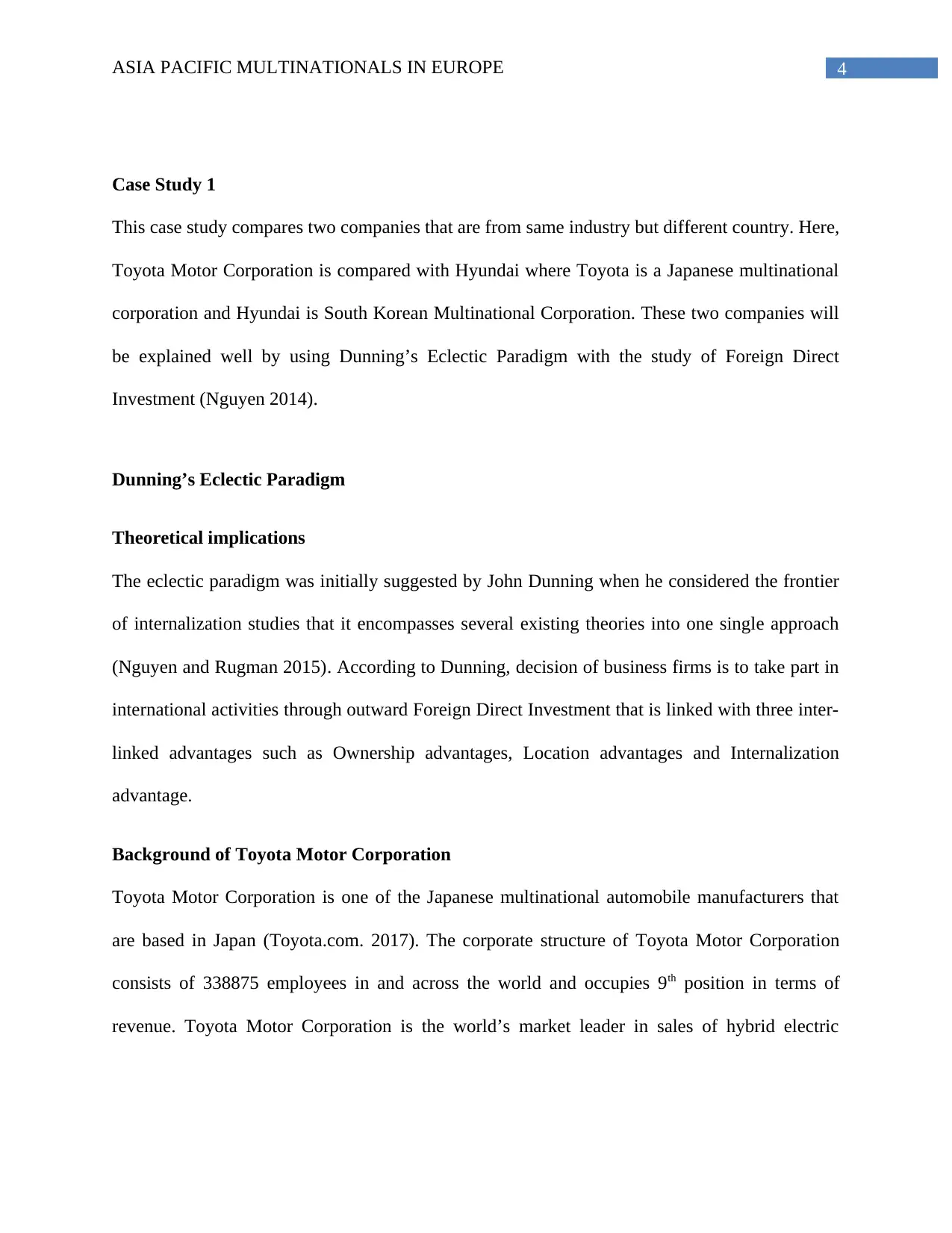
4ASIA PACIFIC MULTINATIONALS IN EUROPE
Case Study 1
This case study compares two companies that are from same industry but different country. Here,
Toyota Motor Corporation is compared with Hyundai where Toyota is a Japanese multinational
corporation and Hyundai is South Korean Multinational Corporation. These two companies will
be explained well by using Dunning’s Eclectic Paradigm with the study of Foreign Direct
Investment (Nguyen 2014).
Dunning’s Eclectic Paradigm
Theoretical implications
The eclectic paradigm was initially suggested by John Dunning when he considered the frontier
of internalization studies that it encompasses several existing theories into one single approach
(Nguyen and Rugman 2015). According to Dunning, decision of business firms is to take part in
international activities through outward Foreign Direct Investment that is linked with three inter-
linked advantages such as Ownership advantages, Location advantages and Internalization
advantage.
Background of Toyota Motor Corporation
Toyota Motor Corporation is one of the Japanese multinational automobile manufacturers that
are based in Japan (Toyota.com. 2017). The corporate structure of Toyota Motor Corporation
consists of 338875 employees in and across the world and occupies 9th position in terms of
revenue. Toyota Motor Corporation is the world’s market leader in sales of hybrid electric
Case Study 1
This case study compares two companies that are from same industry but different country. Here,
Toyota Motor Corporation is compared with Hyundai where Toyota is a Japanese multinational
corporation and Hyundai is South Korean Multinational Corporation. These two companies will
be explained well by using Dunning’s Eclectic Paradigm with the study of Foreign Direct
Investment (Nguyen 2014).
Dunning’s Eclectic Paradigm
Theoretical implications
The eclectic paradigm was initially suggested by John Dunning when he considered the frontier
of internalization studies that it encompasses several existing theories into one single approach
(Nguyen and Rugman 2015). According to Dunning, decision of business firms is to take part in
international activities through outward Foreign Direct Investment that is linked with three inter-
linked advantages such as Ownership advantages, Location advantages and Internalization
advantage.
Background of Toyota Motor Corporation
Toyota Motor Corporation is one of the Japanese multinational automobile manufacturers that
are based in Japan (Toyota.com. 2017). The corporate structure of Toyota Motor Corporation
consists of 338875 employees in and across the world and occupies 9th position in terms of
revenue. Toyota Motor Corporation is the world’s market leader in sales of hybrid electric
Secure Best Marks with AI Grader
Need help grading? Try our AI Grader for instant feedback on your assignments.
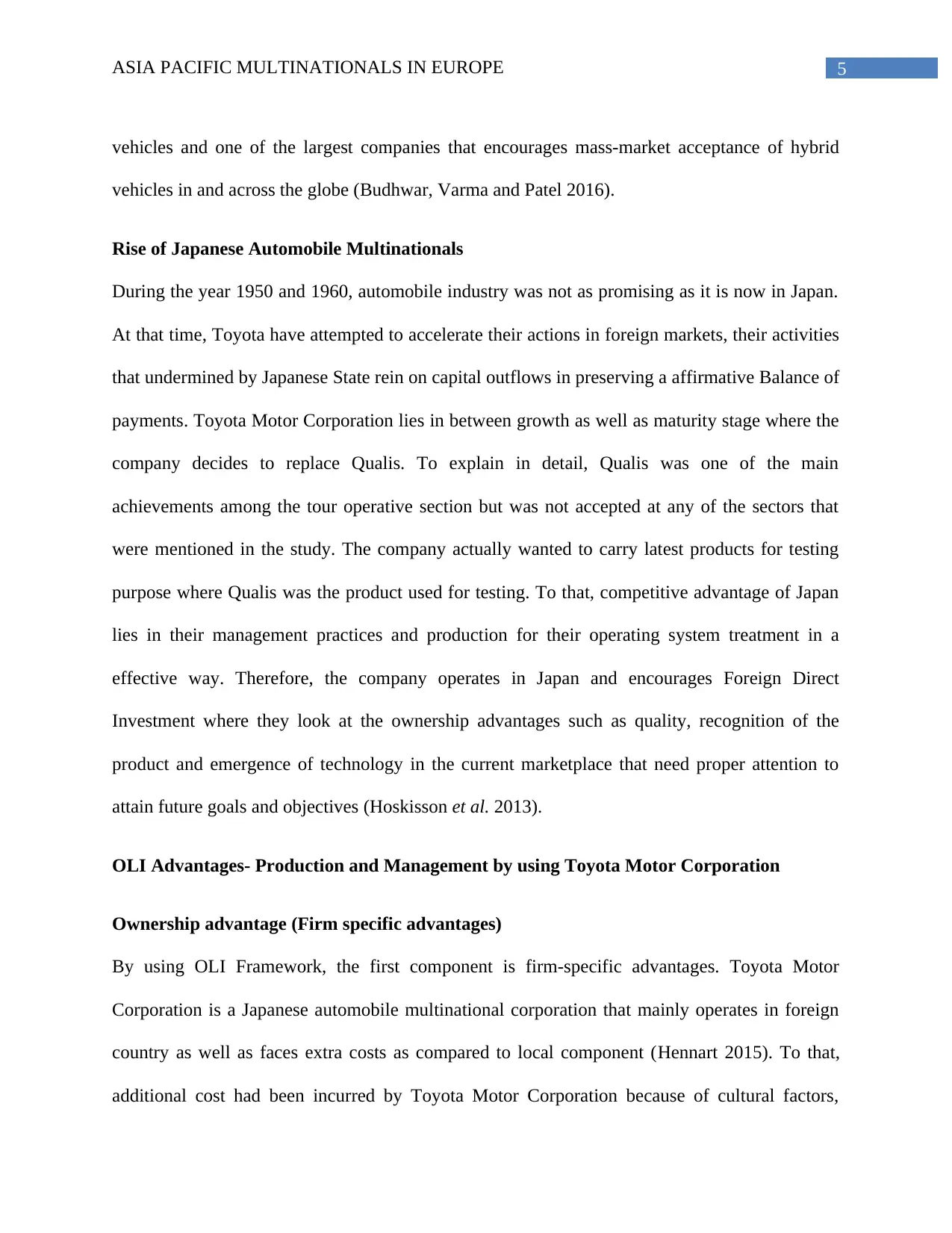
5ASIA PACIFIC MULTINATIONALS IN EUROPE
vehicles and one of the largest companies that encourages mass-market acceptance of hybrid
vehicles in and across the globe (Budhwar, Varma and Patel 2016).
Rise of Japanese Automobile Multinationals
During the year 1950 and 1960, automobile industry was not as promising as it is now in Japan.
At that time, Toyota have attempted to accelerate their actions in foreign markets, their activities
that undermined by Japanese State rein on capital outflows in preserving a affirmative Balance of
payments. Toyota Motor Corporation lies in between growth as well as maturity stage where the
company decides to replace Qualis. To explain in detail, Qualis was one of the main
achievements among the tour operative section but was not accepted at any of the sectors that
were mentioned in the study. The company actually wanted to carry latest products for testing
purpose where Qualis was the product used for testing. To that, competitive advantage of Japan
lies in their management practices and production for their operating system treatment in a
effective way. Therefore, the company operates in Japan and encourages Foreign Direct
Investment where they look at the ownership advantages such as quality, recognition of the
product and emergence of technology in the current marketplace that need proper attention to
attain future goals and objectives (Hoskisson et al. 2013).
OLI Advantages- Production and Management by using Toyota Motor Corporation
Ownership advantage (Firm specific advantages)
By using OLI Framework, the first component is firm-specific advantages. Toyota Motor
Corporation is a Japanese automobile multinational corporation that mainly operates in foreign
country as well as faces extra costs as compared to local component (Hennart 2015). To that,
additional cost had been incurred by Toyota Motor Corporation because of cultural factors,
vehicles and one of the largest companies that encourages mass-market acceptance of hybrid
vehicles in and across the globe (Budhwar, Varma and Patel 2016).
Rise of Japanese Automobile Multinationals
During the year 1950 and 1960, automobile industry was not as promising as it is now in Japan.
At that time, Toyota have attempted to accelerate their actions in foreign markets, their activities
that undermined by Japanese State rein on capital outflows in preserving a affirmative Balance of
payments. Toyota Motor Corporation lies in between growth as well as maturity stage where the
company decides to replace Qualis. To explain in detail, Qualis was one of the main
achievements among the tour operative section but was not accepted at any of the sectors that
were mentioned in the study. The company actually wanted to carry latest products for testing
purpose where Qualis was the product used for testing. To that, competitive advantage of Japan
lies in their management practices and production for their operating system treatment in a
effective way. Therefore, the company operates in Japan and encourages Foreign Direct
Investment where they look at the ownership advantages such as quality, recognition of the
product and emergence of technology in the current marketplace that need proper attention to
attain future goals and objectives (Hoskisson et al. 2013).
OLI Advantages- Production and Management by using Toyota Motor Corporation
Ownership advantage (Firm specific advantages)
By using OLI Framework, the first component is firm-specific advantages. Toyota Motor
Corporation is a Japanese automobile multinational corporation that mainly operates in foreign
country as well as faces extra costs as compared to local component (Hennart 2015). To that,
additional cost had been incurred by Toyota Motor Corporation because of cultural factors,
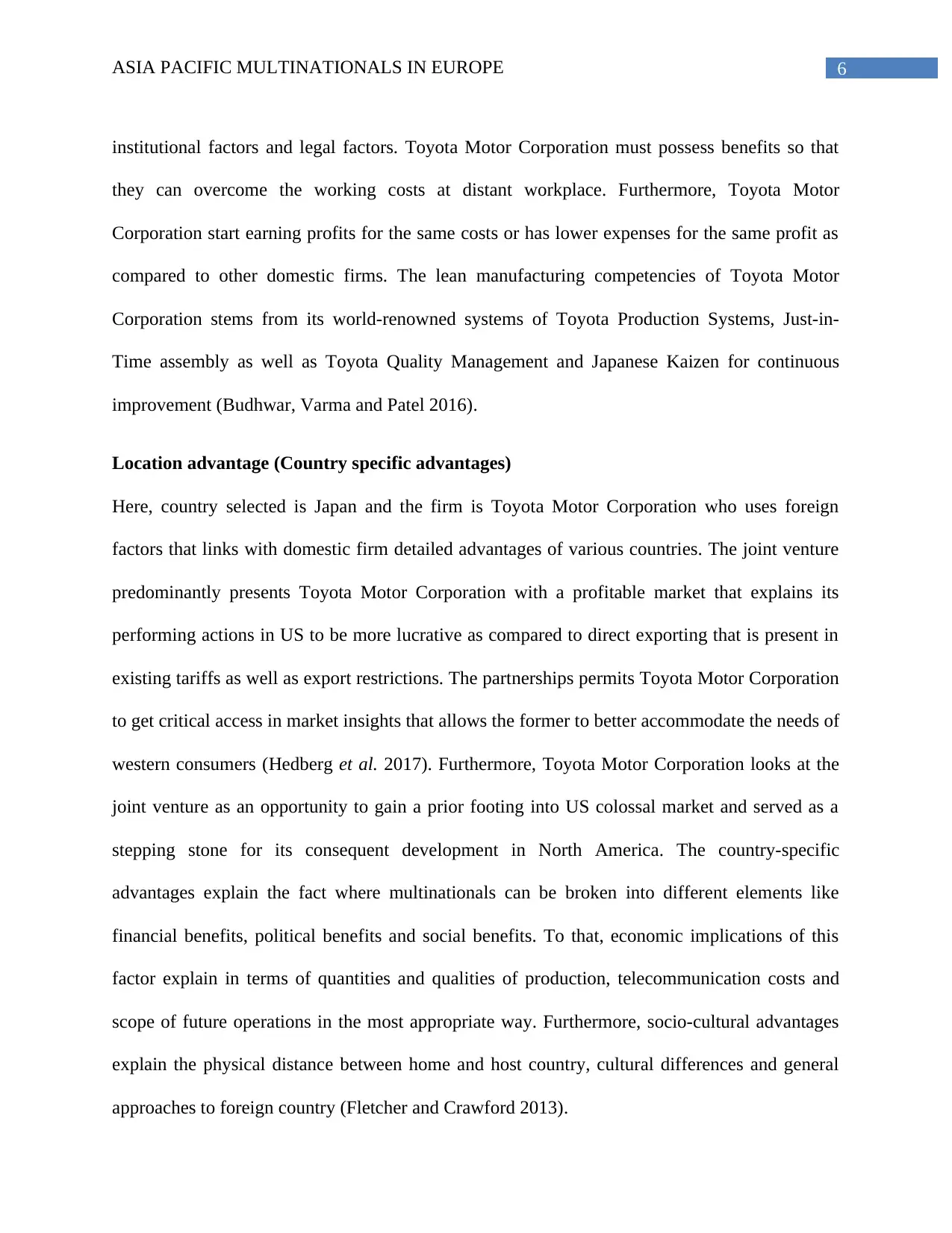
6ASIA PACIFIC MULTINATIONALS IN EUROPE
institutional factors and legal factors. Toyota Motor Corporation must possess benefits so that
they can overcome the working costs at distant workplace. Furthermore, Toyota Motor
Corporation start earning profits for the same costs or has lower expenses for the same profit as
compared to other domestic firms. The lean manufacturing competencies of Toyota Motor
Corporation stems from its world-renowned systems of Toyota Production Systems, Just-in-
Time assembly as well as Toyota Quality Management and Japanese Kaizen for continuous
improvement (Budhwar, Varma and Patel 2016).
Location advantage (Country specific advantages)
Here, country selected is Japan and the firm is Toyota Motor Corporation who uses foreign
factors that links with domestic firm detailed advantages of various countries. The joint venture
predominantly presents Toyota Motor Corporation with a profitable market that explains its
performing actions in US to be more lucrative as compared to direct exporting that is present in
existing tariffs as well as export restrictions. The partnerships permits Toyota Motor Corporation
to get critical access in market insights that allows the former to better accommodate the needs of
western consumers (Hedberg et al. 2017). Furthermore, Toyota Motor Corporation looks at the
joint venture as an opportunity to gain a prior footing into US colossal market and served as a
stepping stone for its consequent development in North America. The country-specific
advantages explain the fact where multinationals can be broken into different elements like
financial benefits, political benefits and social benefits. To that, economic implications of this
factor explain in terms of quantities and qualities of production, telecommunication costs and
scope of future operations in the most appropriate way. Furthermore, socio-cultural advantages
explain the physical distance between home and host country, cultural differences and general
approaches to foreign country (Fletcher and Crawford 2013).
institutional factors and legal factors. Toyota Motor Corporation must possess benefits so that
they can overcome the working costs at distant workplace. Furthermore, Toyota Motor
Corporation start earning profits for the same costs or has lower expenses for the same profit as
compared to other domestic firms. The lean manufacturing competencies of Toyota Motor
Corporation stems from its world-renowned systems of Toyota Production Systems, Just-in-
Time assembly as well as Toyota Quality Management and Japanese Kaizen for continuous
improvement (Budhwar, Varma and Patel 2016).
Location advantage (Country specific advantages)
Here, country selected is Japan and the firm is Toyota Motor Corporation who uses foreign
factors that links with domestic firm detailed advantages of various countries. The joint venture
predominantly presents Toyota Motor Corporation with a profitable market that explains its
performing actions in US to be more lucrative as compared to direct exporting that is present in
existing tariffs as well as export restrictions. The partnerships permits Toyota Motor Corporation
to get critical access in market insights that allows the former to better accommodate the needs of
western consumers (Hedberg et al. 2017). Furthermore, Toyota Motor Corporation looks at the
joint venture as an opportunity to gain a prior footing into US colossal market and served as a
stepping stone for its consequent development in North America. The country-specific
advantages explain the fact where multinationals can be broken into different elements like
financial benefits, political benefits and social benefits. To that, economic implications of this
factor explain in terms of quantities and qualities of production, telecommunication costs and
scope of future operations in the most appropriate way. Furthermore, socio-cultural advantages
explain the physical distance between home and host country, cultural differences and general
approaches to foreign country (Fletcher and Crawford 2013).
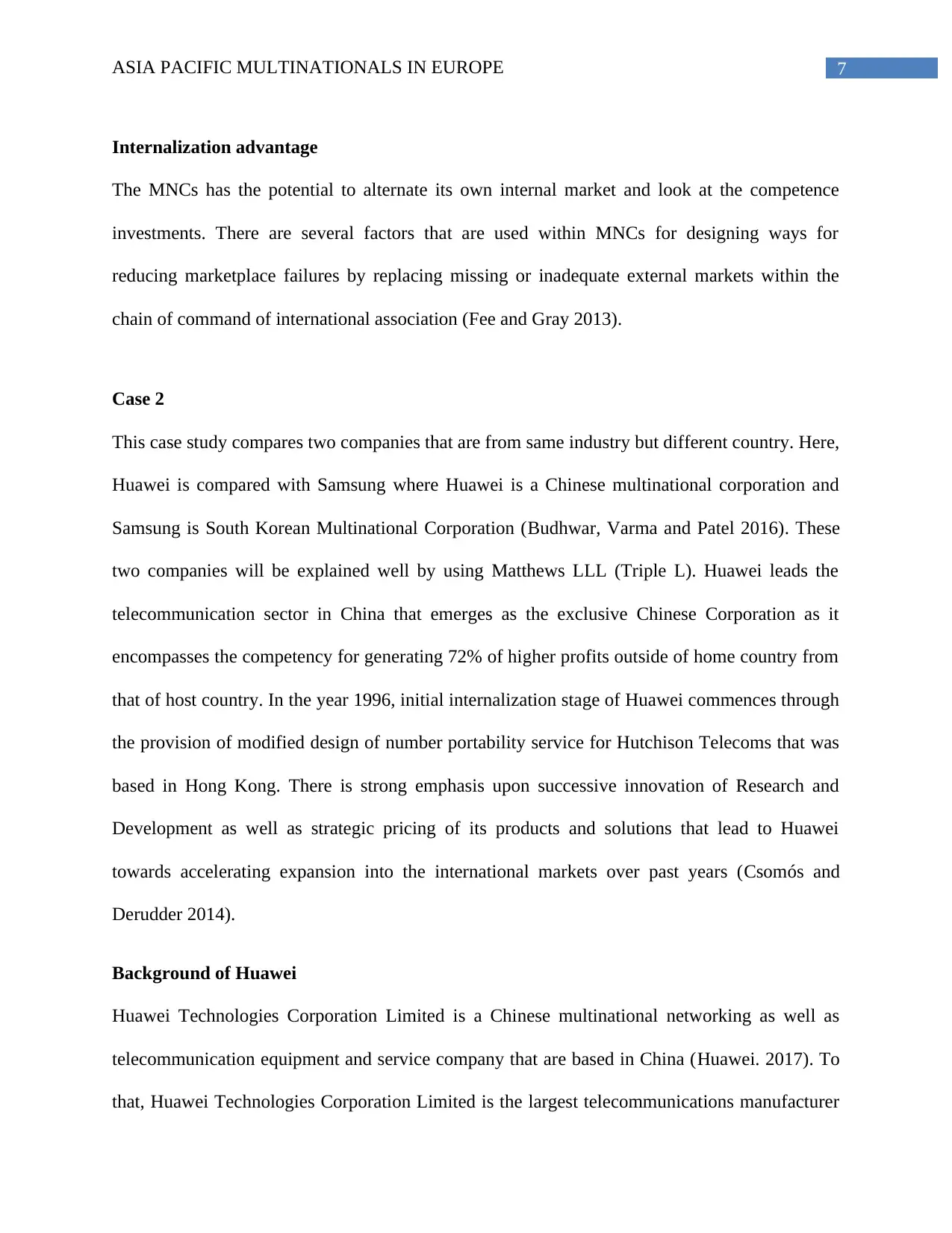
7ASIA PACIFIC MULTINATIONALS IN EUROPE
Internalization advantage
The MNCs has the potential to alternate its own internal market and look at the competence
investments. There are several factors that are used within MNCs for designing ways for
reducing marketplace failures by replacing missing or inadequate external markets within the
chain of command of international association (Fee and Gray 2013).
Case 2
This case study compares two companies that are from same industry but different country. Here,
Huawei is compared with Samsung where Huawei is a Chinese multinational corporation and
Samsung is South Korean Multinational Corporation (Budhwar, Varma and Patel 2016). These
two companies will be explained well by using Matthews LLL (Triple L). Huawei leads the
telecommunication sector in China that emerges as the exclusive Chinese Corporation as it
encompasses the competency for generating 72% of higher profits outside of home country from
that of host country. In the year 1996, initial internalization stage of Huawei commences through
the provision of modified design of number portability service for Hutchison Telecoms that was
based in Hong Kong. There is strong emphasis upon successive innovation of Research and
Development as well as strategic pricing of its products and solutions that lead to Huawei
towards accelerating expansion into the international markets over past years (Csomós and
Derudder 2014).
Background of Huawei
Huawei Technologies Corporation Limited is a Chinese multinational networking as well as
telecommunication equipment and service company that are based in China (Huawei. 2017). To
that, Huawei Technologies Corporation Limited is the largest telecommunications manufacturer
Internalization advantage
The MNCs has the potential to alternate its own internal market and look at the competence
investments. There are several factors that are used within MNCs for designing ways for
reducing marketplace failures by replacing missing or inadequate external markets within the
chain of command of international association (Fee and Gray 2013).
Case 2
This case study compares two companies that are from same industry but different country. Here,
Huawei is compared with Samsung where Huawei is a Chinese multinational corporation and
Samsung is South Korean Multinational Corporation (Budhwar, Varma and Patel 2016). These
two companies will be explained well by using Matthews LLL (Triple L). Huawei leads the
telecommunication sector in China that emerges as the exclusive Chinese Corporation as it
encompasses the competency for generating 72% of higher profits outside of home country from
that of host country. In the year 1996, initial internalization stage of Huawei commences through
the provision of modified design of number portability service for Hutchison Telecoms that was
based in Hong Kong. There is strong emphasis upon successive innovation of Research and
Development as well as strategic pricing of its products and solutions that lead to Huawei
towards accelerating expansion into the international markets over past years (Csomós and
Derudder 2014).
Background of Huawei
Huawei Technologies Corporation Limited is a Chinese multinational networking as well as
telecommunication equipment and service company that are based in China (Huawei. 2017). To
that, Huawei Technologies Corporation Limited is the largest telecommunications manufacturer
Paraphrase This Document
Need a fresh take? Get an instant paraphrase of this document with our AI Paraphraser
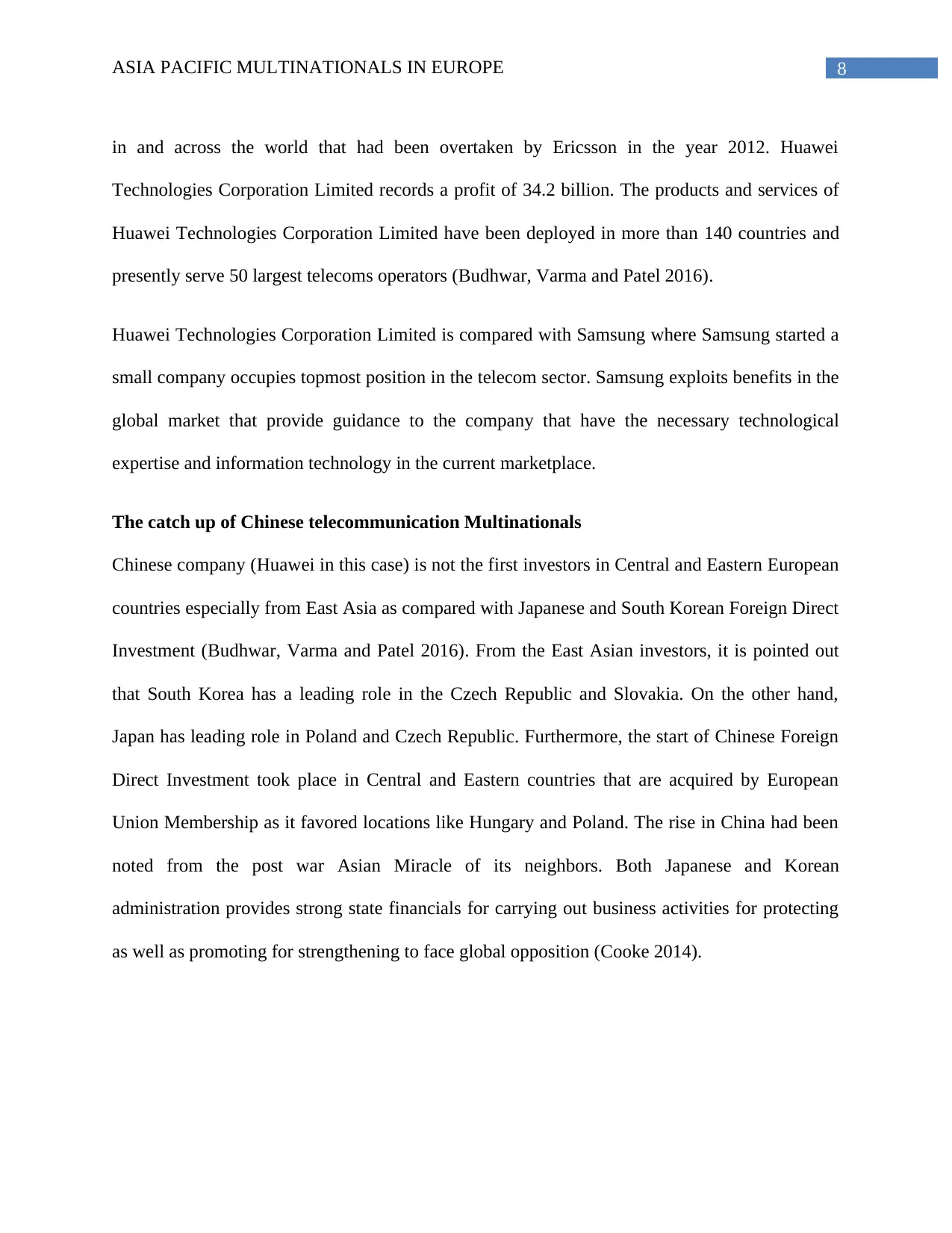
8ASIA PACIFIC MULTINATIONALS IN EUROPE
in and across the world that had been overtaken by Ericsson in the year 2012. Huawei
Technologies Corporation Limited records a profit of 34.2 billion. The products and services of
Huawei Technologies Corporation Limited have been deployed in more than 140 countries and
presently serve 50 largest telecoms operators (Budhwar, Varma and Patel 2016).
Huawei Technologies Corporation Limited is compared with Samsung where Samsung started a
small company occupies topmost position in the telecom sector. Samsung exploits benefits in the
global market that provide guidance to the company that have the necessary technological
expertise and information technology in the current marketplace.
The catch up of Chinese telecommunication Multinationals
Chinese company (Huawei in this case) is not the first investors in Central and Eastern European
countries especially from East Asia as compared with Japanese and South Korean Foreign Direct
Investment (Budhwar, Varma and Patel 2016). From the East Asian investors, it is pointed out
that South Korea has a leading role in the Czech Republic and Slovakia. On the other hand,
Japan has leading role in Poland and Czech Republic. Furthermore, the start of Chinese Foreign
Direct Investment took place in Central and Eastern countries that are acquired by European
Union Membership as it favored locations like Hungary and Poland. The rise in China had been
noted from the post war Asian Miracle of its neighbors. Both Japanese and Korean
administration provides strong state financials for carrying out business activities for protecting
as well as promoting for strengthening to face global opposition (Cooke 2014).
in and across the world that had been overtaken by Ericsson in the year 2012. Huawei
Technologies Corporation Limited records a profit of 34.2 billion. The products and services of
Huawei Technologies Corporation Limited have been deployed in more than 140 countries and
presently serve 50 largest telecoms operators (Budhwar, Varma and Patel 2016).
Huawei Technologies Corporation Limited is compared with Samsung where Samsung started a
small company occupies topmost position in the telecom sector. Samsung exploits benefits in the
global market that provide guidance to the company that have the necessary technological
expertise and information technology in the current marketplace.
The catch up of Chinese telecommunication Multinationals
Chinese company (Huawei in this case) is not the first investors in Central and Eastern European
countries especially from East Asia as compared with Japanese and South Korean Foreign Direct
Investment (Budhwar, Varma and Patel 2016). From the East Asian investors, it is pointed out
that South Korea has a leading role in the Czech Republic and Slovakia. On the other hand,
Japan has leading role in Poland and Czech Republic. Furthermore, the start of Chinese Foreign
Direct Investment took place in Central and Eastern countries that are acquired by European
Union Membership as it favored locations like Hungary and Poland. The rise in China had been
noted from the post war Asian Miracle of its neighbors. Both Japanese and Korean
administration provides strong state financials for carrying out business activities for protecting
as well as promoting for strengthening to face global opposition (Cooke 2014).
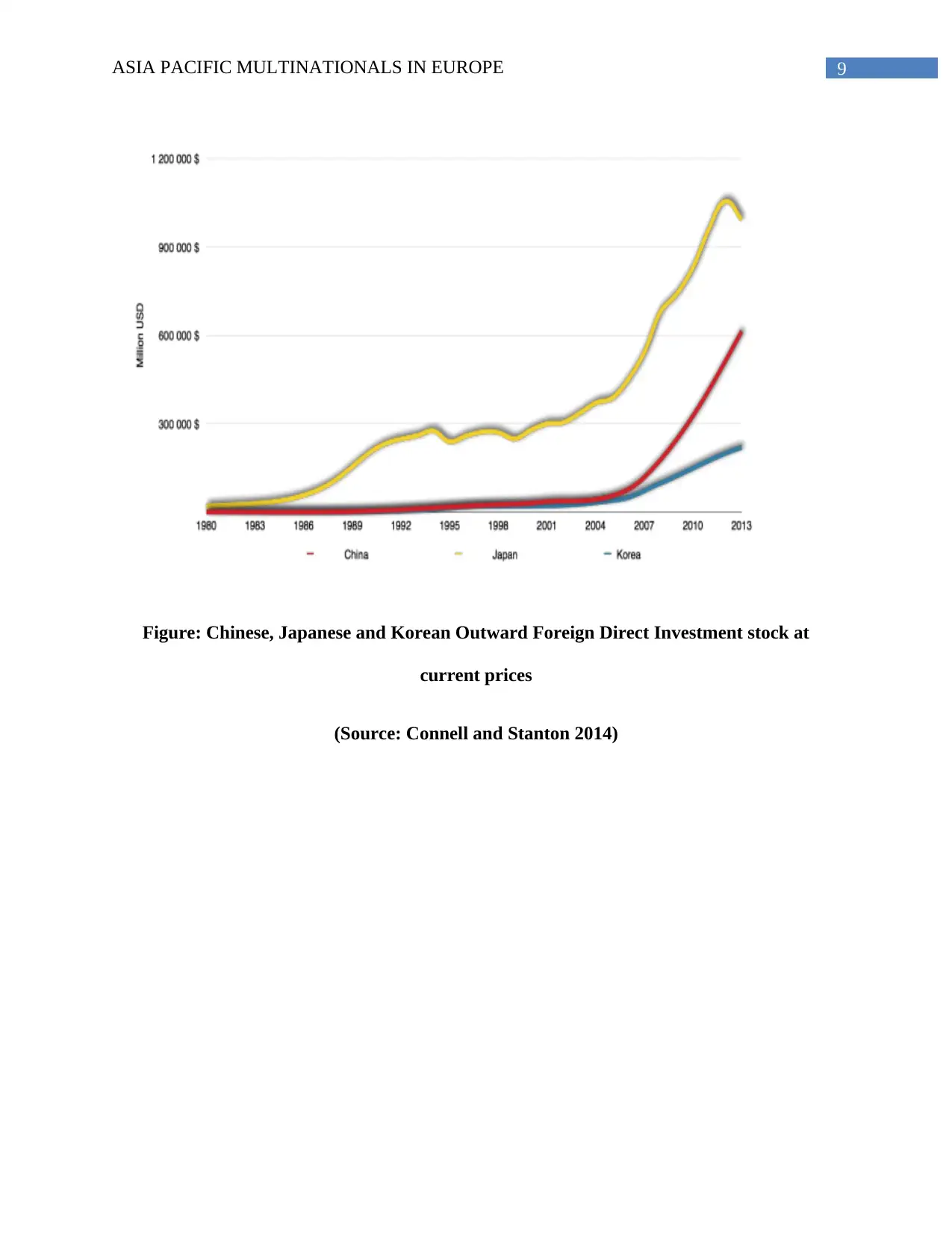
9ASIA PACIFIC MULTINATIONALS IN EUROPE
Figure: Chinese, Japanese and Korean Outward Foreign Direct Investment stock at
current prices
(Source: Connell and Stanton 2014)
Figure: Chinese, Japanese and Korean Outward Foreign Direct Investment stock at
current prices
(Source: Connell and Stanton 2014)
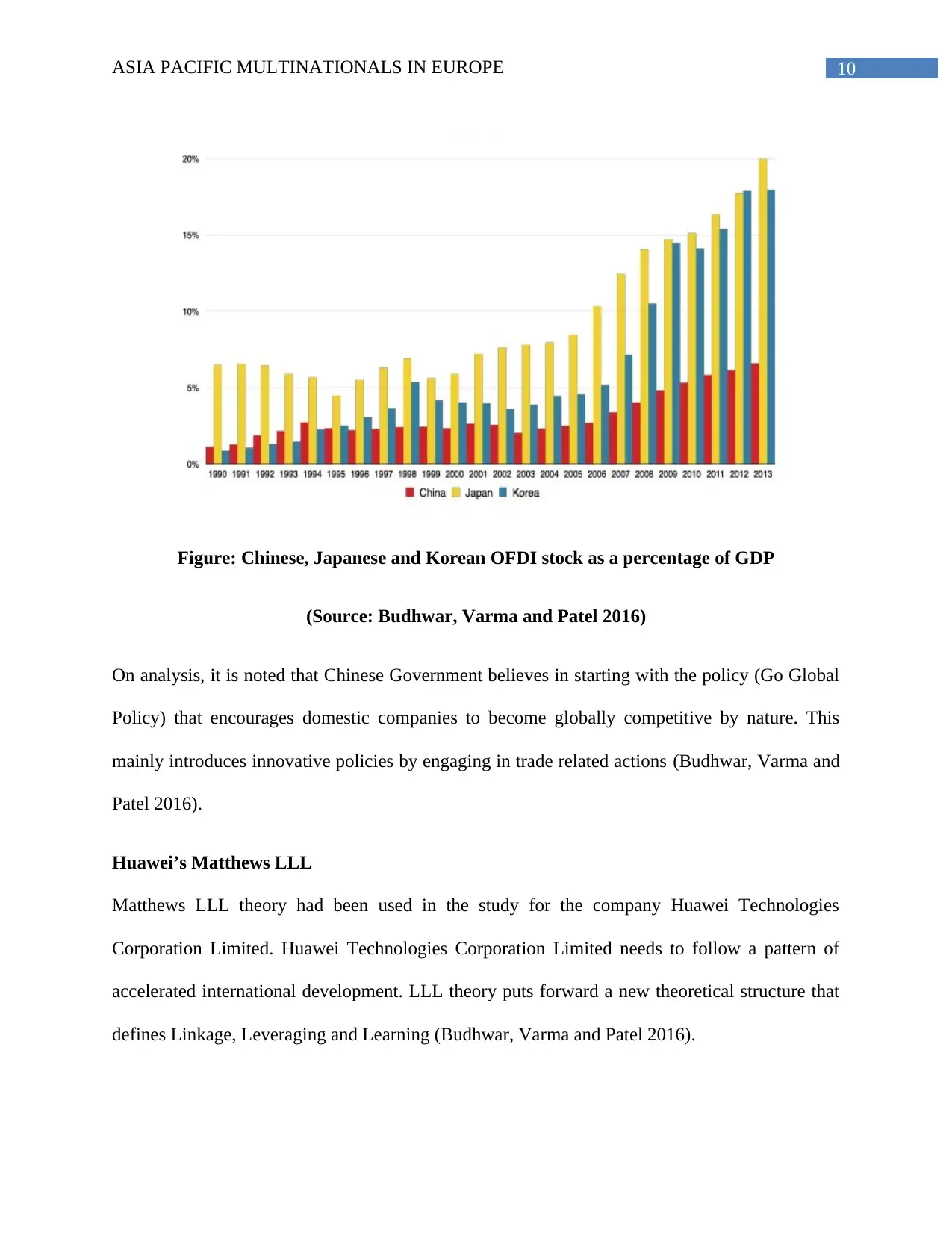
10ASIA PACIFIC MULTINATIONALS IN EUROPE
Figure: Chinese, Japanese and Korean OFDI stock as a percentage of GDP
(Source: Budhwar, Varma and Patel 2016)
On analysis, it is noted that Chinese Government believes in starting with the policy (Go Global
Policy) that encourages domestic companies to become globally competitive by nature. This
mainly introduces innovative policies by engaging in trade related actions (Budhwar, Varma and
Patel 2016).
Huawei’s Matthews LLL
Matthews LLL theory had been used in the study for the company Huawei Technologies
Corporation Limited. Huawei Technologies Corporation Limited needs to follow a pattern of
accelerated international development. LLL theory puts forward a new theoretical structure that
defines Linkage, Leveraging and Learning (Budhwar, Varma and Patel 2016).
Figure: Chinese, Japanese and Korean OFDI stock as a percentage of GDP
(Source: Budhwar, Varma and Patel 2016)
On analysis, it is noted that Chinese Government believes in starting with the policy (Go Global
Policy) that encourages domestic companies to become globally competitive by nature. This
mainly introduces innovative policies by engaging in trade related actions (Budhwar, Varma and
Patel 2016).
Huawei’s Matthews LLL
Matthews LLL theory had been used in the study for the company Huawei Technologies
Corporation Limited. Huawei Technologies Corporation Limited needs to follow a pattern of
accelerated international development. LLL theory puts forward a new theoretical structure that
defines Linkage, Leveraging and Learning (Budhwar, Varma and Patel 2016).
Secure Best Marks with AI Grader
Need help grading? Try our AI Grader for instant feedback on your assignments.
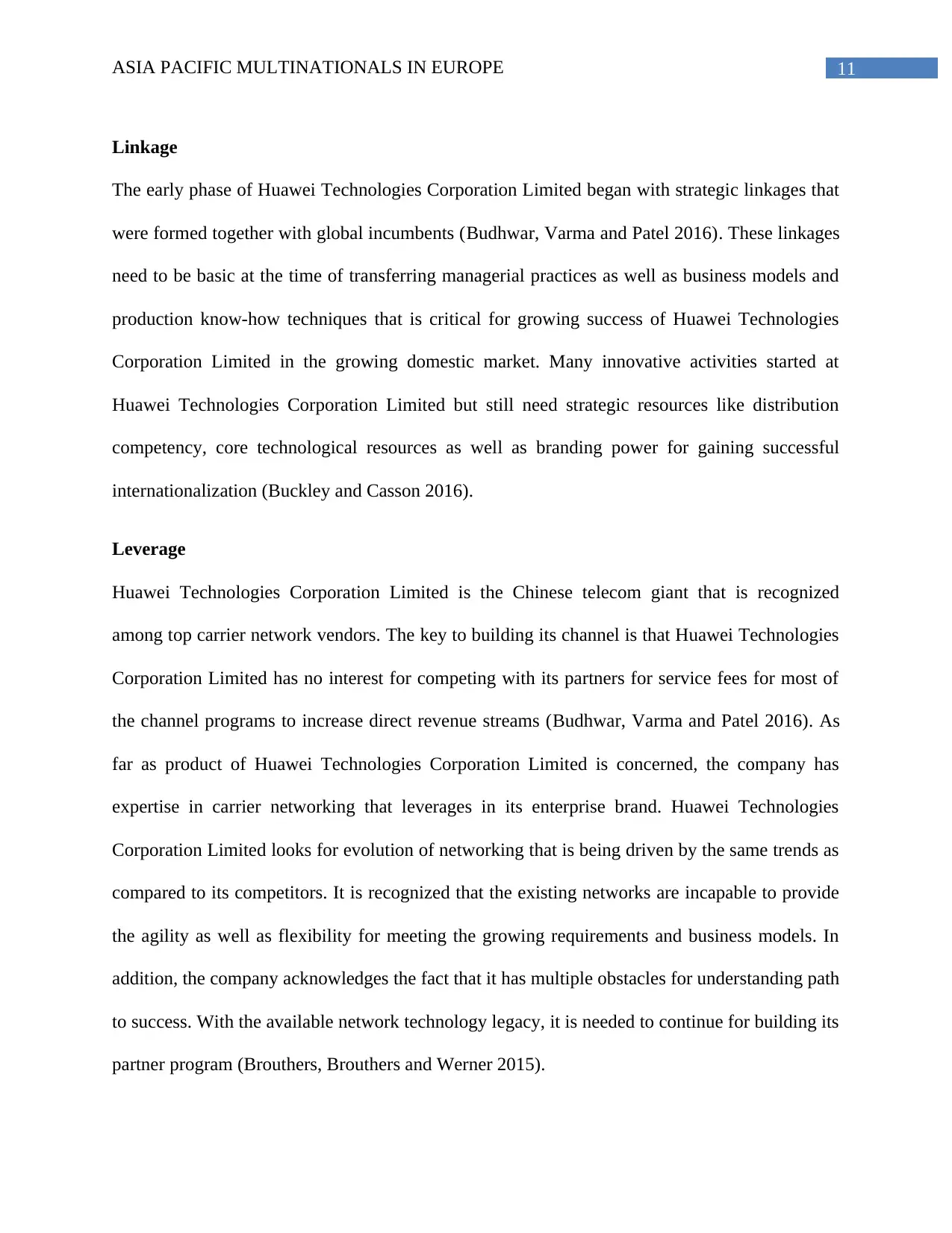
11ASIA PACIFIC MULTINATIONALS IN EUROPE
Linkage
The early phase of Huawei Technologies Corporation Limited began with strategic linkages that
were formed together with global incumbents (Budhwar, Varma and Patel 2016). These linkages
need to be basic at the time of transferring managerial practices as well as business models and
production know-how techniques that is critical for growing success of Huawei Technologies
Corporation Limited in the growing domestic market. Many innovative activities started at
Huawei Technologies Corporation Limited but still need strategic resources like distribution
competency, core technological resources as well as branding power for gaining successful
internationalization (Buckley and Casson 2016).
Leverage
Huawei Technologies Corporation Limited is the Chinese telecom giant that is recognized
among top carrier network vendors. The key to building its channel is that Huawei Technologies
Corporation Limited has no interest for competing with its partners for service fees for most of
the channel programs to increase direct revenue streams (Budhwar, Varma and Patel 2016). As
far as product of Huawei Technologies Corporation Limited is concerned, the company has
expertise in carrier networking that leverages in its enterprise brand. Huawei Technologies
Corporation Limited looks for evolution of networking that is being driven by the same trends as
compared to its competitors. It is recognized that the existing networks are incapable to provide
the agility as well as flexibility for meeting the growing requirements and business models. In
addition, the company acknowledges the fact that it has multiple obstacles for understanding path
to success. With the available network technology legacy, it is needed to continue for building its
partner program (Brouthers, Brouthers and Werner 2015).
Linkage
The early phase of Huawei Technologies Corporation Limited began with strategic linkages that
were formed together with global incumbents (Budhwar, Varma and Patel 2016). These linkages
need to be basic at the time of transferring managerial practices as well as business models and
production know-how techniques that is critical for growing success of Huawei Technologies
Corporation Limited in the growing domestic market. Many innovative activities started at
Huawei Technologies Corporation Limited but still need strategic resources like distribution
competency, core technological resources as well as branding power for gaining successful
internationalization (Buckley and Casson 2016).
Leverage
Huawei Technologies Corporation Limited is the Chinese telecom giant that is recognized
among top carrier network vendors. The key to building its channel is that Huawei Technologies
Corporation Limited has no interest for competing with its partners for service fees for most of
the channel programs to increase direct revenue streams (Budhwar, Varma and Patel 2016). As
far as product of Huawei Technologies Corporation Limited is concerned, the company has
expertise in carrier networking that leverages in its enterprise brand. Huawei Technologies
Corporation Limited looks for evolution of networking that is being driven by the same trends as
compared to its competitors. It is recognized that the existing networks are incapable to provide
the agility as well as flexibility for meeting the growing requirements and business models. In
addition, the company acknowledges the fact that it has multiple obstacles for understanding path
to success. With the available network technology legacy, it is needed to continue for building its
partner program (Brouthers, Brouthers and Werner 2015).
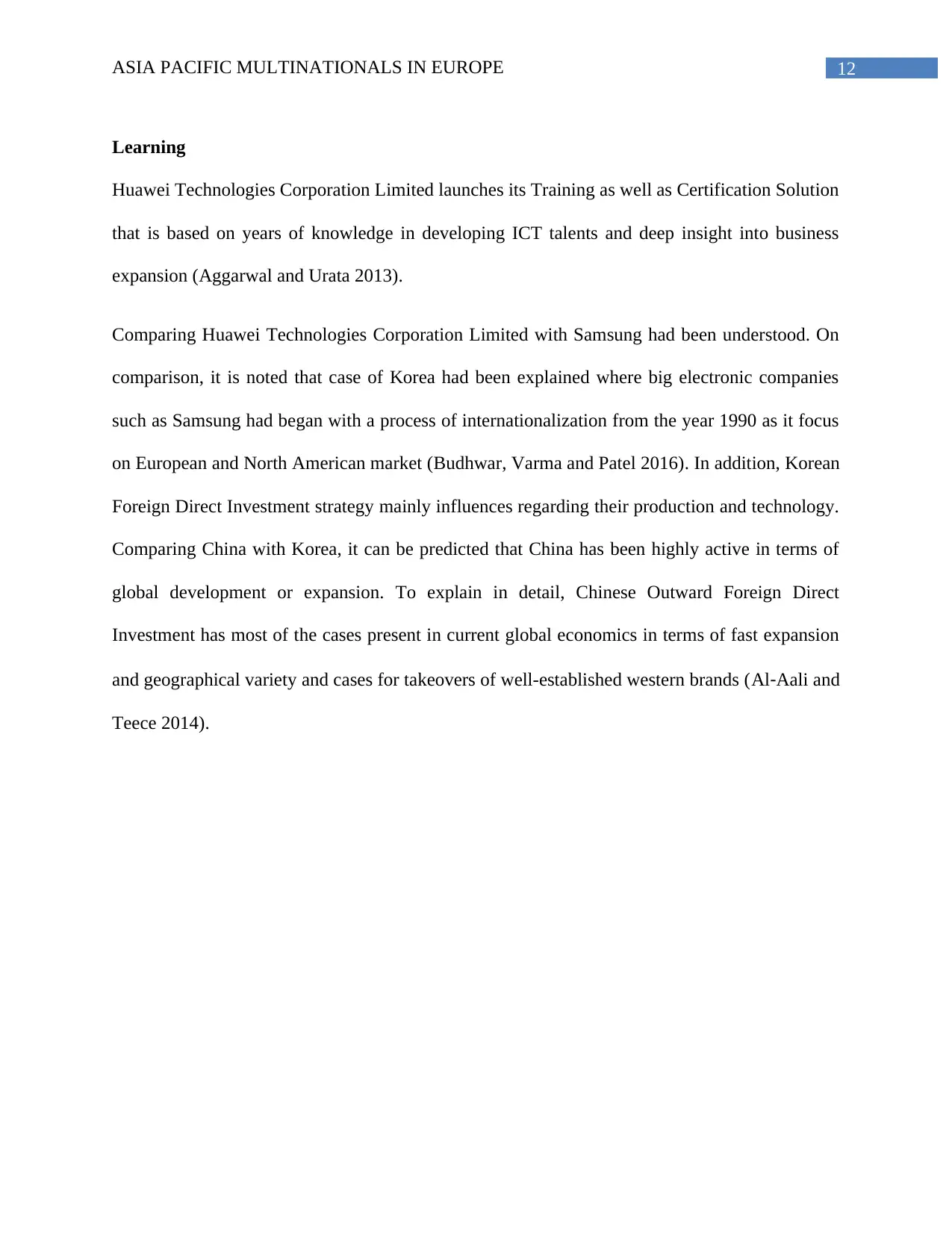
12ASIA PACIFIC MULTINATIONALS IN EUROPE
Learning
Huawei Technologies Corporation Limited launches its Training as well as Certification Solution
that is based on years of knowledge in developing ICT talents and deep insight into business
expansion (Aggarwal and Urata 2013).
Comparing Huawei Technologies Corporation Limited with Samsung had been understood. On
comparison, it is noted that case of Korea had been explained where big electronic companies
such as Samsung had began with a process of internationalization from the year 1990 as it focus
on European and North American market (Budhwar, Varma and Patel 2016). In addition, Korean
Foreign Direct Investment strategy mainly influences regarding their production and technology.
Comparing China with Korea, it can be predicted that China has been highly active in terms of
global development or expansion. To explain in detail, Chinese Outward Foreign Direct
Investment has most of the cases present in current global economics in terms of fast expansion
and geographical variety and cases for takeovers of well-established western brands (Al‐Aali and
Teece 2014).
Learning
Huawei Technologies Corporation Limited launches its Training as well as Certification Solution
that is based on years of knowledge in developing ICT talents and deep insight into business
expansion (Aggarwal and Urata 2013).
Comparing Huawei Technologies Corporation Limited with Samsung had been understood. On
comparison, it is noted that case of Korea had been explained where big electronic companies
such as Samsung had began with a process of internationalization from the year 1990 as it focus
on European and North American market (Budhwar, Varma and Patel 2016). In addition, Korean
Foreign Direct Investment strategy mainly influences regarding their production and technology.
Comparing China with Korea, it can be predicted that China has been highly active in terms of
global development or expansion. To explain in detail, Chinese Outward Foreign Direct
Investment has most of the cases present in current global economics in terms of fast expansion
and geographical variety and cases for takeovers of well-established western brands (Al‐Aali and
Teece 2014).
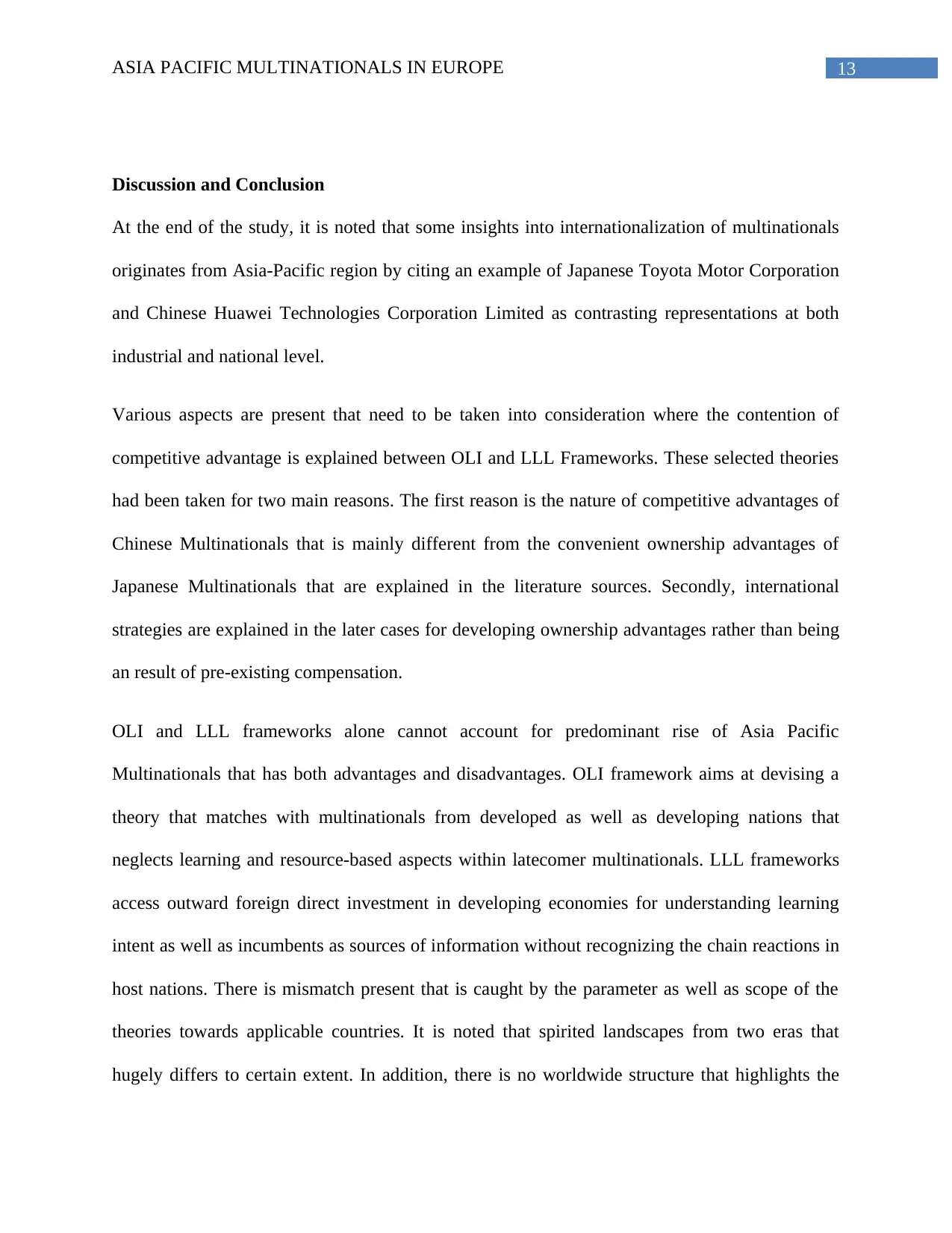
13ASIA PACIFIC MULTINATIONALS IN EUROPE
Discussion and Conclusion
At the end of the study, it is noted that some insights into internationalization of multinationals
originates from Asia-Pacific region by citing an example of Japanese Toyota Motor Corporation
and Chinese Huawei Technologies Corporation Limited as contrasting representations at both
industrial and national level.
Various aspects are present that need to be taken into consideration where the contention of
competitive advantage is explained between OLI and LLL Frameworks. These selected theories
had been taken for two main reasons. The first reason is the nature of competitive advantages of
Chinese Multinationals that is mainly different from the convenient ownership advantages of
Japanese Multinationals that are explained in the literature sources. Secondly, international
strategies are explained in the later cases for developing ownership advantages rather than being
an result of pre-existing compensation.
OLI and LLL frameworks alone cannot account for predominant rise of Asia Pacific
Multinationals that has both advantages and disadvantages. OLI framework aims at devising a
theory that matches with multinationals from developed as well as developing nations that
neglects learning and resource-based aspects within latecomer multinationals. LLL frameworks
access outward foreign direct investment in developing economies for understanding learning
intent as well as incumbents as sources of information without recognizing the chain reactions in
host nations. There is mismatch present that is caught by the parameter as well as scope of the
theories towards applicable countries. It is noted that spirited landscapes from two eras that
hugely differs to certain extent. In addition, there is no worldwide structure that highlights the
Discussion and Conclusion
At the end of the study, it is noted that some insights into internationalization of multinationals
originates from Asia-Pacific region by citing an example of Japanese Toyota Motor Corporation
and Chinese Huawei Technologies Corporation Limited as contrasting representations at both
industrial and national level.
Various aspects are present that need to be taken into consideration where the contention of
competitive advantage is explained between OLI and LLL Frameworks. These selected theories
had been taken for two main reasons. The first reason is the nature of competitive advantages of
Chinese Multinationals that is mainly different from the convenient ownership advantages of
Japanese Multinationals that are explained in the literature sources. Secondly, international
strategies are explained in the later cases for developing ownership advantages rather than being
an result of pre-existing compensation.
OLI and LLL frameworks alone cannot account for predominant rise of Asia Pacific
Multinationals that has both advantages and disadvantages. OLI framework aims at devising a
theory that matches with multinationals from developed as well as developing nations that
neglects learning and resource-based aspects within latecomer multinationals. LLL frameworks
access outward foreign direct investment in developing economies for understanding learning
intent as well as incumbents as sources of information without recognizing the chain reactions in
host nations. There is mismatch present that is caught by the parameter as well as scope of the
theories towards applicable countries. It is noted that spirited landscapes from two eras that
hugely differs to certain extent. In addition, there is no worldwide structure that highlights the
Paraphrase This Document
Need a fresh take? Get an instant paraphrase of this document with our AI Paraphraser
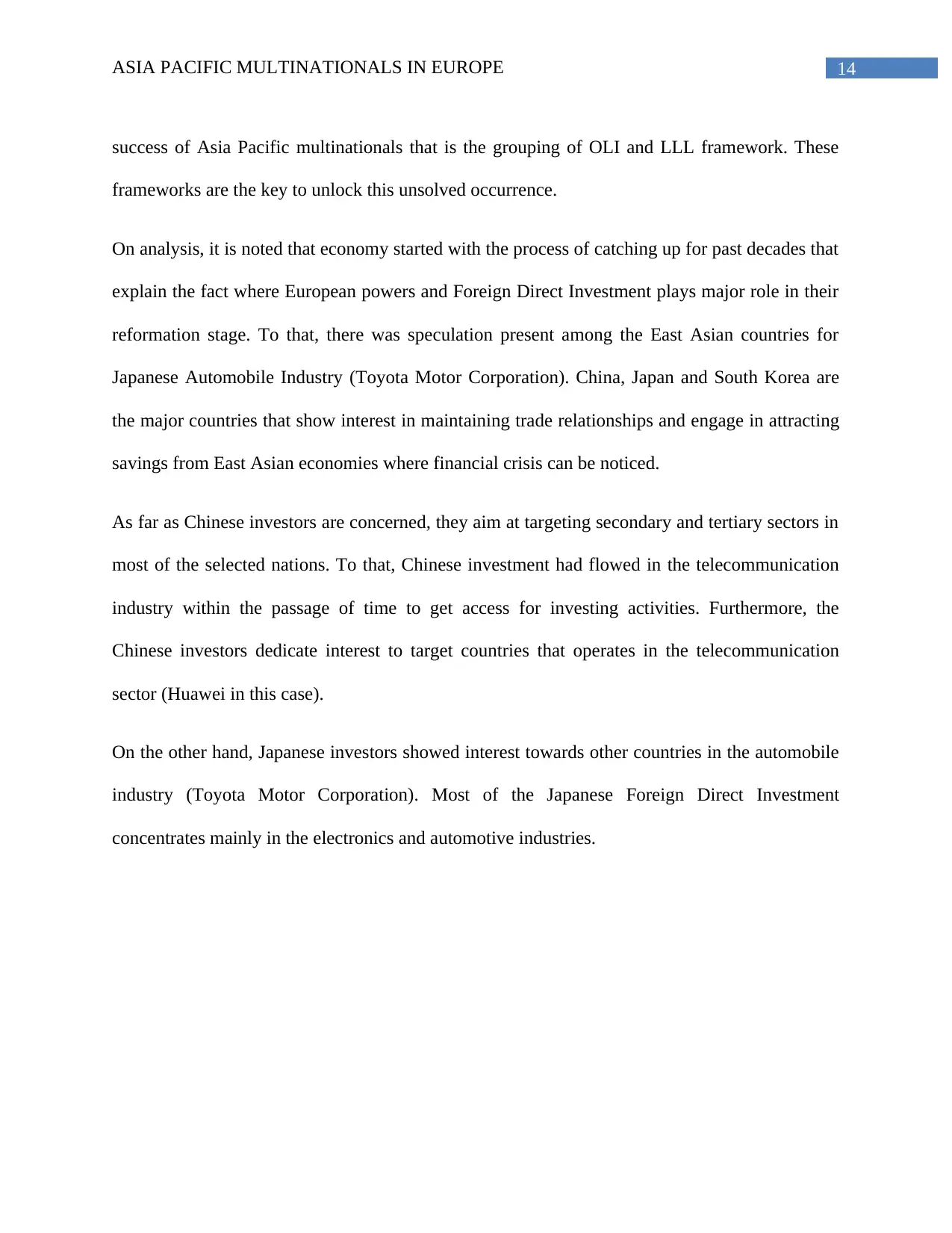
14ASIA PACIFIC MULTINATIONALS IN EUROPE
success of Asia Pacific multinationals that is the grouping of OLI and LLL framework. These
frameworks are the key to unlock this unsolved occurrence.
On analysis, it is noted that economy started with the process of catching up for past decades that
explain the fact where European powers and Foreign Direct Investment plays major role in their
reformation stage. To that, there was speculation present among the East Asian countries for
Japanese Automobile Industry (Toyota Motor Corporation). China, Japan and South Korea are
the major countries that show interest in maintaining trade relationships and engage in attracting
savings from East Asian economies where financial crisis can be noticed.
As far as Chinese investors are concerned, they aim at targeting secondary and tertiary sectors in
most of the selected nations. To that, Chinese investment had flowed in the telecommunication
industry within the passage of time to get access for investing activities. Furthermore, the
Chinese investors dedicate interest to target countries that operates in the telecommunication
sector (Huawei in this case).
On the other hand, Japanese investors showed interest towards other countries in the automobile
industry (Toyota Motor Corporation). Most of the Japanese Foreign Direct Investment
concentrates mainly in the electronics and automotive industries.
success of Asia Pacific multinationals that is the grouping of OLI and LLL framework. These
frameworks are the key to unlock this unsolved occurrence.
On analysis, it is noted that economy started with the process of catching up for past decades that
explain the fact where European powers and Foreign Direct Investment plays major role in their
reformation stage. To that, there was speculation present among the East Asian countries for
Japanese Automobile Industry (Toyota Motor Corporation). China, Japan and South Korea are
the major countries that show interest in maintaining trade relationships and engage in attracting
savings from East Asian economies where financial crisis can be noticed.
As far as Chinese investors are concerned, they aim at targeting secondary and tertiary sectors in
most of the selected nations. To that, Chinese investment had flowed in the telecommunication
industry within the passage of time to get access for investing activities. Furthermore, the
Chinese investors dedicate interest to target countries that operates in the telecommunication
sector (Huawei in this case).
On the other hand, Japanese investors showed interest towards other countries in the automobile
industry (Toyota Motor Corporation). Most of the Japanese Foreign Direct Investment
concentrates mainly in the electronics and automotive industries.
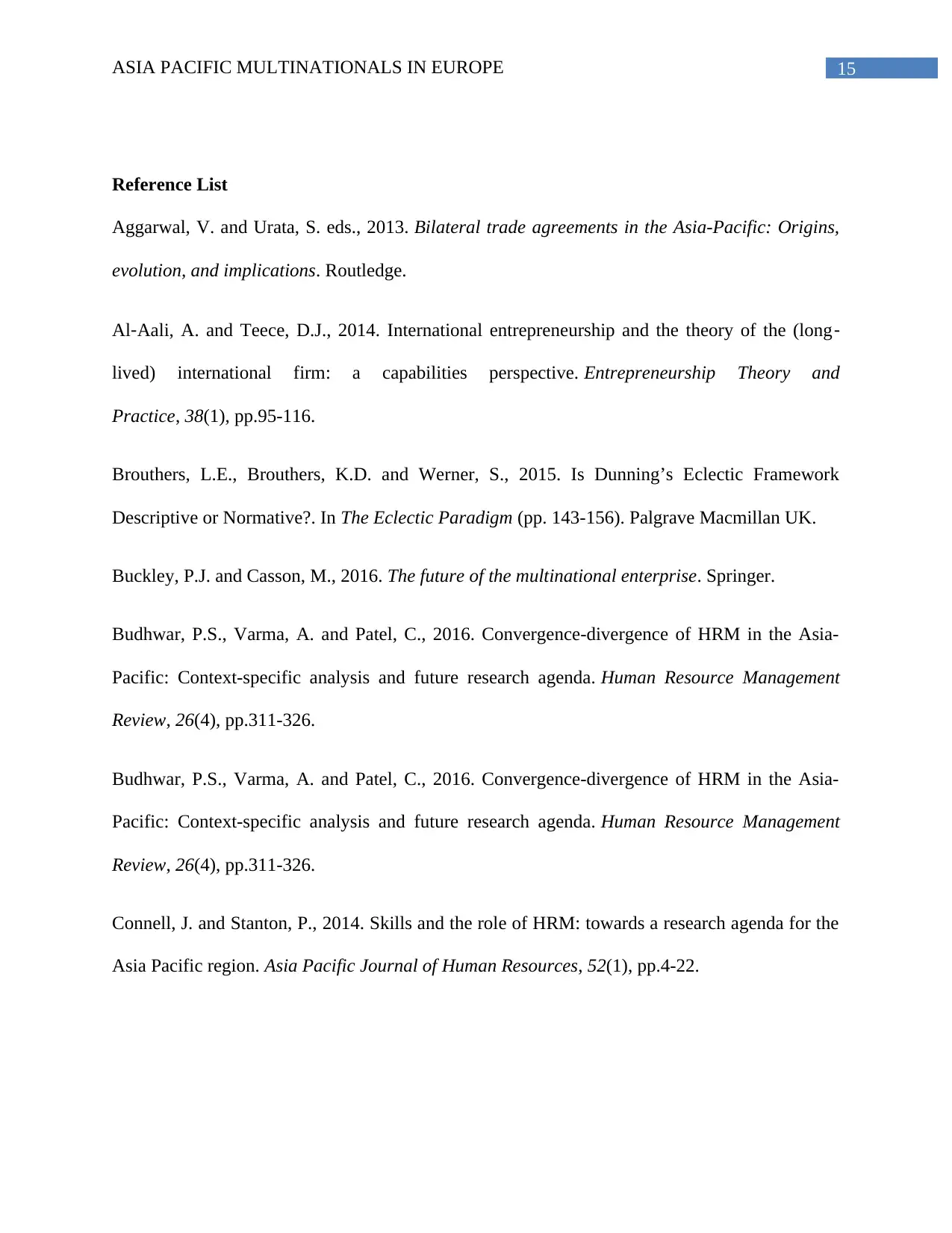
15ASIA PACIFIC MULTINATIONALS IN EUROPE
Reference List
Aggarwal, V. and Urata, S. eds., 2013. Bilateral trade agreements in the Asia-Pacific: Origins,
evolution, and implications. Routledge.
Al‐Aali, A. and Teece, D.J., 2014. International entrepreneurship and the theory of the (long‐
lived) international firm: a capabilities perspective. Entrepreneurship Theory and
Practice, 38(1), pp.95-116.
Brouthers, L.E., Brouthers, K.D. and Werner, S., 2015. Is Dunning’s Eclectic Framework
Descriptive or Normative?. In The Eclectic Paradigm (pp. 143-156). Palgrave Macmillan UK.
Buckley, P.J. and Casson, M., 2016. The future of the multinational enterprise. Springer.
Budhwar, P.S., Varma, A. and Patel, C., 2016. Convergence-divergence of HRM in the Asia-
Pacific: Context-specific analysis and future research agenda. Human Resource Management
Review, 26(4), pp.311-326.
Budhwar, P.S., Varma, A. and Patel, C., 2016. Convergence-divergence of HRM in the Asia-
Pacific: Context-specific analysis and future research agenda. Human Resource Management
Review, 26(4), pp.311-326.
Connell, J. and Stanton, P., 2014. Skills and the role of HRM: towards a research agenda for the
Asia Pacific region. Asia Pacific Journal of Human Resources, 52(1), pp.4-22.
Reference List
Aggarwal, V. and Urata, S. eds., 2013. Bilateral trade agreements in the Asia-Pacific: Origins,
evolution, and implications. Routledge.
Al‐Aali, A. and Teece, D.J., 2014. International entrepreneurship and the theory of the (long‐
lived) international firm: a capabilities perspective. Entrepreneurship Theory and
Practice, 38(1), pp.95-116.
Brouthers, L.E., Brouthers, K.D. and Werner, S., 2015. Is Dunning’s Eclectic Framework
Descriptive or Normative?. In The Eclectic Paradigm (pp. 143-156). Palgrave Macmillan UK.
Buckley, P.J. and Casson, M., 2016. The future of the multinational enterprise. Springer.
Budhwar, P.S., Varma, A. and Patel, C., 2016. Convergence-divergence of HRM in the Asia-
Pacific: Context-specific analysis and future research agenda. Human Resource Management
Review, 26(4), pp.311-326.
Budhwar, P.S., Varma, A. and Patel, C., 2016. Convergence-divergence of HRM in the Asia-
Pacific: Context-specific analysis and future research agenda. Human Resource Management
Review, 26(4), pp.311-326.
Connell, J. and Stanton, P., 2014. Skills and the role of HRM: towards a research agenda for the
Asia Pacific region. Asia Pacific Journal of Human Resources, 52(1), pp.4-22.
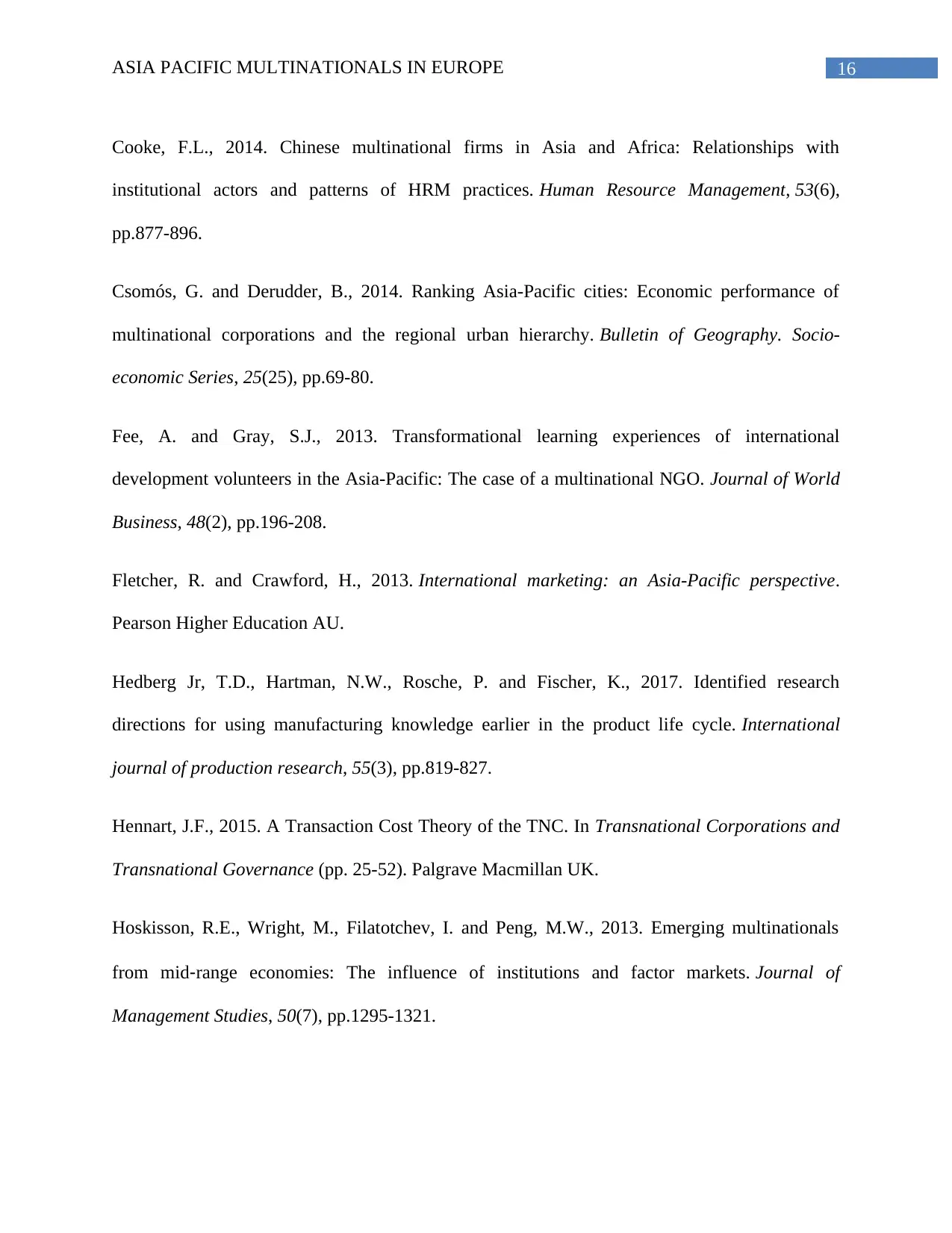
16ASIA PACIFIC MULTINATIONALS IN EUROPE
Cooke, F.L., 2014. Chinese multinational firms in Asia and Africa: Relationships with
institutional actors and patterns of HRM practices. Human Resource Management, 53(6),
pp.877-896.
Csomós, G. and Derudder, B., 2014. Ranking Asia-Pacific cities: Economic performance of
multinational corporations and the regional urban hierarchy. Bulletin of Geography. Socio-
economic Series, 25(25), pp.69-80.
Fee, A. and Gray, S.J., 2013. Transformational learning experiences of international
development volunteers in the Asia-Pacific: The case of a multinational NGO. Journal of World
Business, 48(2), pp.196-208.
Fletcher, R. and Crawford, H., 2013. International marketing: an Asia-Pacific perspective.
Pearson Higher Education AU.
Hedberg Jr, T.D., Hartman, N.W., Rosche, P. and Fischer, K., 2017. Identified research
directions for using manufacturing knowledge earlier in the product life cycle. International
journal of production research, 55(3), pp.819-827.
Hennart, J.F., 2015. A Transaction Cost Theory of the TNC. In Transnational Corporations and
Transnational Governance (pp. 25-52). Palgrave Macmillan UK.
Hoskisson, R.E., Wright, M., Filatotchev, I. and Peng, M.W., 2013. Emerging multinationals
from mid‐range economies: The influence of institutions and factor markets. Journal of
Management Studies, 50(7), pp.1295-1321.
Cooke, F.L., 2014. Chinese multinational firms in Asia and Africa: Relationships with
institutional actors and patterns of HRM practices. Human Resource Management, 53(6),
pp.877-896.
Csomós, G. and Derudder, B., 2014. Ranking Asia-Pacific cities: Economic performance of
multinational corporations and the regional urban hierarchy. Bulletin of Geography. Socio-
economic Series, 25(25), pp.69-80.
Fee, A. and Gray, S.J., 2013. Transformational learning experiences of international
development volunteers in the Asia-Pacific: The case of a multinational NGO. Journal of World
Business, 48(2), pp.196-208.
Fletcher, R. and Crawford, H., 2013. International marketing: an Asia-Pacific perspective.
Pearson Higher Education AU.
Hedberg Jr, T.D., Hartman, N.W., Rosche, P. and Fischer, K., 2017. Identified research
directions for using manufacturing knowledge earlier in the product life cycle. International
journal of production research, 55(3), pp.819-827.
Hennart, J.F., 2015. A Transaction Cost Theory of the TNC. In Transnational Corporations and
Transnational Governance (pp. 25-52). Palgrave Macmillan UK.
Hoskisson, R.E., Wright, M., Filatotchev, I. and Peng, M.W., 2013. Emerging multinationals
from mid‐range economies: The influence of institutions and factor markets. Journal of
Management Studies, 50(7), pp.1295-1321.
Secure Best Marks with AI Grader
Need help grading? Try our AI Grader for instant feedback on your assignments.
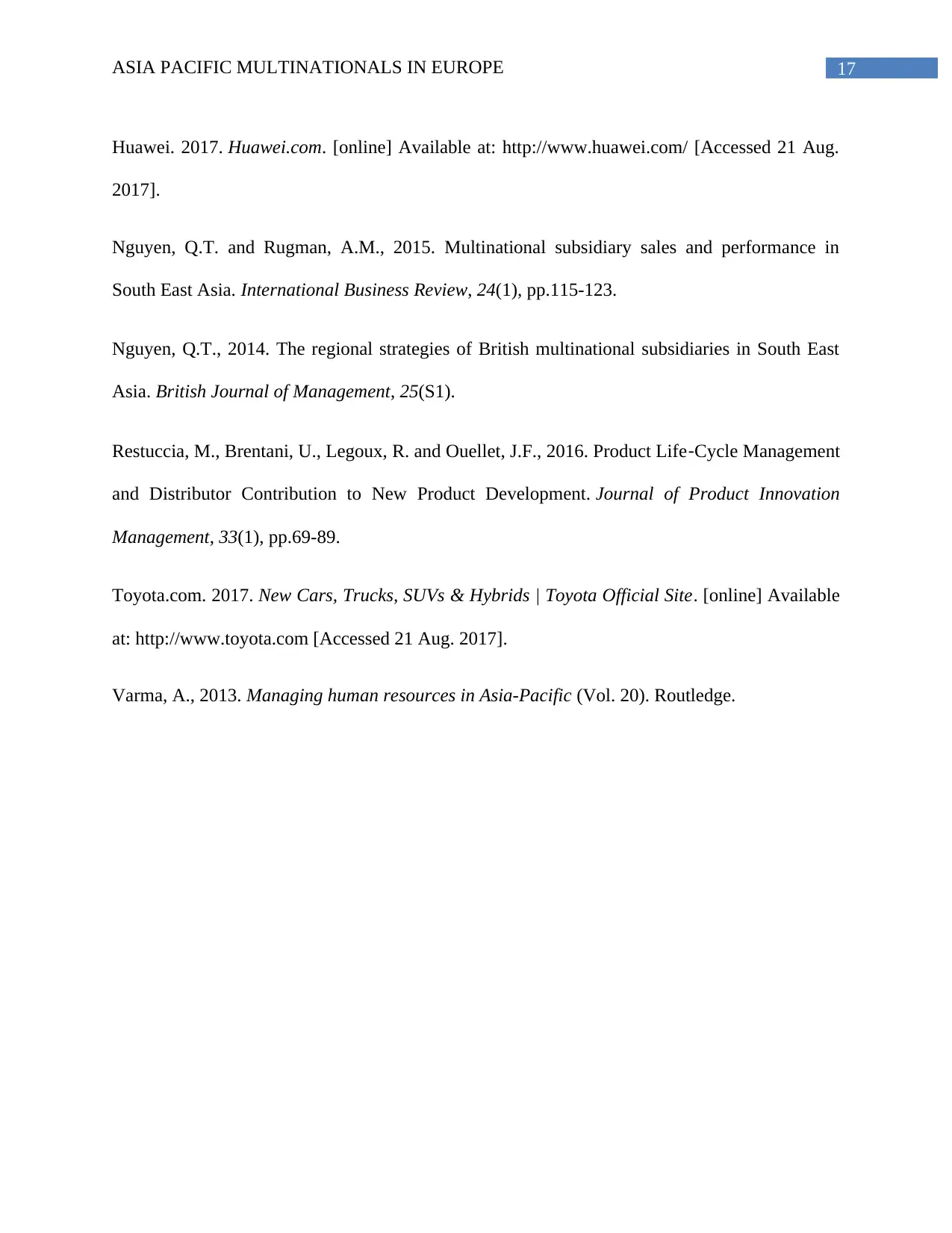
17ASIA PACIFIC MULTINATIONALS IN EUROPE
Huawei. 2017. Huawei.com. [online] Available at: http://www.huawei.com/ [Accessed 21 Aug.
2017].
Nguyen, Q.T. and Rugman, A.M., 2015. Multinational subsidiary sales and performance in
South East Asia. International Business Review, 24(1), pp.115-123.
Nguyen, Q.T., 2014. The regional strategies of British multinational subsidiaries in South East
Asia. British Journal of Management, 25(S1).
Restuccia, M., Brentani, U., Legoux, R. and Ouellet, J.F., 2016. Product Life‐Cycle Management
and Distributor Contribution to New Product Development. Journal of Product Innovation
Management, 33(1), pp.69-89.
Toyota.com. 2017. New Cars, Trucks, SUVs & Hybrids | Toyota Official Site. [online] Available
at: http://www.toyota.com [Accessed 21 Aug. 2017].
Varma, A., 2013. Managing human resources in Asia-Pacific (Vol. 20). Routledge.
Huawei. 2017. Huawei.com. [online] Available at: http://www.huawei.com/ [Accessed 21 Aug.
2017].
Nguyen, Q.T. and Rugman, A.M., 2015. Multinational subsidiary sales and performance in
South East Asia. International Business Review, 24(1), pp.115-123.
Nguyen, Q.T., 2014. The regional strategies of British multinational subsidiaries in South East
Asia. British Journal of Management, 25(S1).
Restuccia, M., Brentani, U., Legoux, R. and Ouellet, J.F., 2016. Product Life‐Cycle Management
and Distributor Contribution to New Product Development. Journal of Product Innovation
Management, 33(1), pp.69-89.
Toyota.com. 2017. New Cars, Trucks, SUVs & Hybrids | Toyota Official Site. [online] Available
at: http://www.toyota.com [Accessed 21 Aug. 2017].
Varma, A., 2013. Managing human resources in Asia-Pacific (Vol. 20). Routledge.
1 out of 17
Related Documents
Your All-in-One AI-Powered Toolkit for Academic Success.
+13062052269
info@desklib.com
Available 24*7 on WhatsApp / Email
![[object Object]](/_next/static/media/star-bottom.7253800d.svg)
Unlock your academic potential
© 2024 | Zucol Services PVT LTD | All rights reserved.




